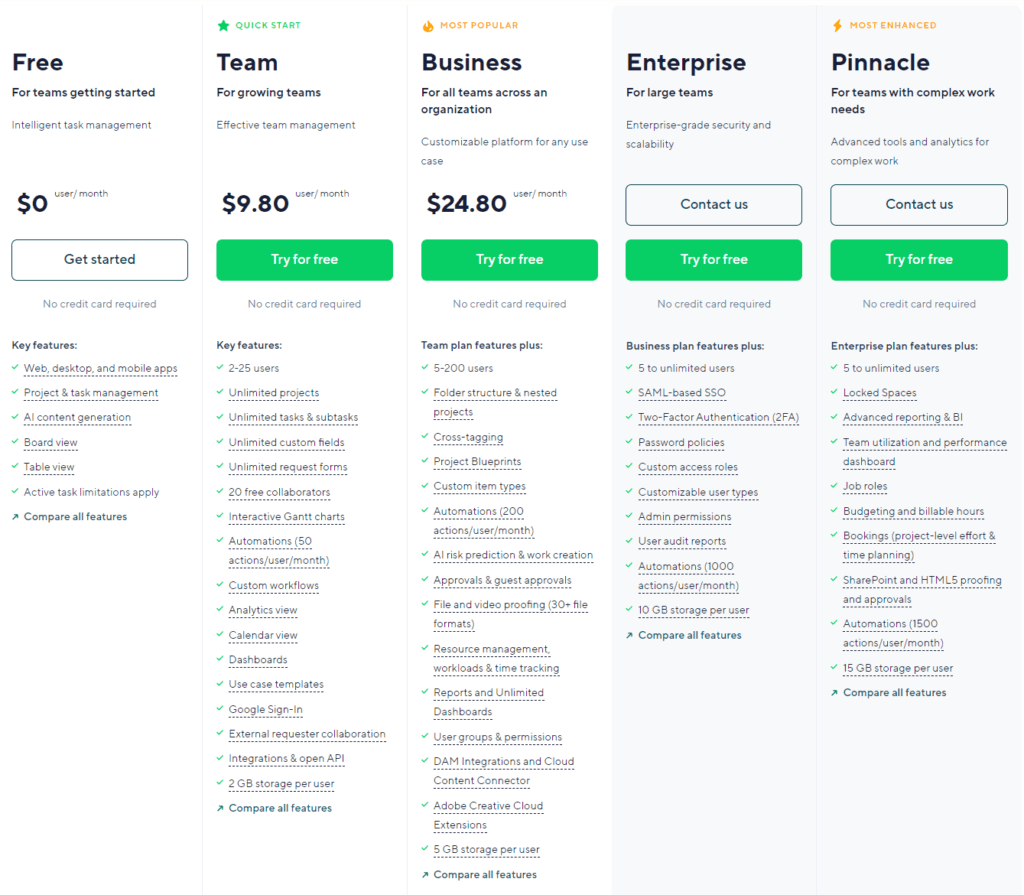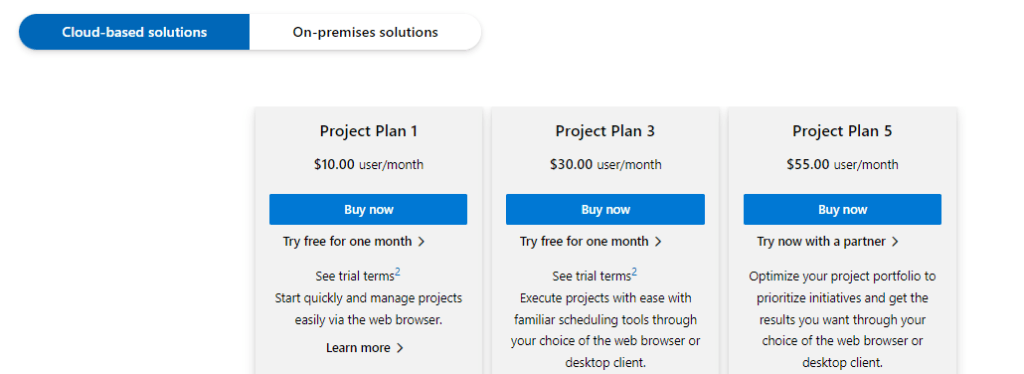In the vast sea of project management tools, two giants stand tall, offering to anchor your projects in the realms of efficiency and clarity: Wrike and Microsoft Project. Each tool brings its unique strengths to the table, promising to transform the way you manage projects, teams, and deadlines. But in the quest to select the tool that best suits your needs, it’s essential to dive deep into the features, flexibility, and functionality that each offers. Let’s embark on a journey to uncover which of these titans – Wrike or Microsoft Project – will be the champion of your project management needs.
| Wrike | Microsoft Project |
|---|---|
| G2 Score – 4.2 out of 5 stars | G2 Score – 4 out of 5 stars |
| TrustRadius Score – 8.2/10 | TrustRadius Score – 7.6/10 |
Ease of Use and User Interface: The First Step on the Journey
When embarking on the quest for the perfect project management tool, the ease of use and user interface is where our journey begins. After all, a tool can only transform your workflow if it’s embraced by your team. Here’s how Wrike and Microsoft Project fare in welcoming users aboard.
Wrike: The Intuitive Navigator
Wrike greets its users with a clean, intuitive interface that’s designed to reduce the friction of managing complex projects. Navigating through tasks, projects, and deadlines feels seamless, thanks to a thoughtful layout that prioritizes user experience. Customization is at the heart of Wrike, allowing teams to tailor their workspace with personalized dashboards, reports, and workflow views. This adaptability extends to its task management, where a drag-and-drop simplicity meets powerful functionality.
But what truly sets Wrike apart is its commitment to making project management accessible to all team members, regardless of their technical proficiency. The learning curve is gentle, inviting users to confidently explore and utilize the tool’s extensive features from day one.
Microsoft Project: The Seasoned Architect
In contrast, Microsoft Project approaches project management with the precision of a seasoned architect. It offers a robust suite of tools designed for detailed project planning, resource allocation, and progress tracking. The interface, while comprehensive, carries with it a steeper learning curve, tailored more towards those with experience in project management or users willing to invest time in mastering its capabilities.
Microsoft Project excels in offering deep customization options for task scheduling, Gantt charts, and detailed reporting. However, this depth comes with complexity that can be daunting for newcomers. The integration with other Microsoft tools adds a layer of familiarity for those already entrenched in the Microsoft ecosystem, making it a powerful extension of the Office suite.
Integration Capabilities: The Digital Symphony
The symphony of project management isn’t just about solo performances; it’s about how well the tool orchestrates with other instruments in your digital ecosystem. Here’s a look at how Wrike and Microsoft Project manage this orchestration.
Wrike: The Agile Connector
Wrike is designed with a keen understanding of the modern digital workspace’s interconnected nature. It offers robust integration capabilities with a wide array of third-party apps and services. From common productivity tools like Google Drive, Dropbox, and Microsoft Office 365, to specialized applications such as Salesforce, GitHub, and JIRA, Wrike ensures that teams can maintain a seamless flow of information across platforms.
Beyond these direct integrations, Wrike’s API allows for custom connections, offering businesses the flexibility to tailor integrations to their specific workflow needs. This is particularly advantageous for organizations that rely on niche tools or have developed in-house software solutions. Wrike’s approach to integration emphasizes flexibility and adaptability, ensuring that regardless of your tech stack, it can fit in harmoniously.
Microsoft Project: The Structured Integrator
Microsoft Project benefits from its position within the Microsoft ecosystem, offering deep integration with other Microsoft tools like Office 365, SharePoint, and Teams. This integration provides a seamless user experience for teams already invested in Microsoft products, enabling easy data sharing, communication, and collaboration within familiar interfaces.
For organizations that operate outside the Microsoft ecosystem or use a diverse set of tools, Microsoft Project offers integration capabilities through Microsoft Power Automate. This allows for the creation of automated workflows between Microsoft Project and a variety of other applications, though it may require more setup and customization compared to Wrike’s direct integrations.

Related: Check out our free SEO suite

Resource Management and Allocation: Steering Projects with Precision
The ability to efficiently manage and allocate resources is a cornerstone of successful project management, affecting everything from project timelines to team morale. Let’s dive into how Wrike and Microsoft Project handle this vital aspect.
Wrike: Dynamic Resource Management
Wrike offers dynamic resource management features designed to provide project managers with insights into team workloads and capacities. Through its interactive Gantt chart, Wrike enables managers to visualize each team member’s tasks over time, making it easier to identify overallocations and adjust assignments as needed. Additionally, Wrike’s Workload view offers a comprehensive overview of individual workloads, helping managers make informed decisions about task assignments and project timelines.
One of Wrike’s strengths in resource management is its flexibility; the platform allows for adjustments on the fly, ensuring that teams can respond quickly to changes in project scope or timelines. Custom fields and reports can also be utilized to track specific resource metrics, offering tailored insights into how resources are being utilized across projects.
Microsoft Project: Structured Resource Allocation
Microsoft Project brings a structured approach to resource management, with extensive features that cater to detailed planning and allocation. It allows project managers to define resources, whether they are team members, equipment, or materials, and assign them to tasks with specified work hours. The platform’s Resource Management view provides a detailed breakdown of where and how resources are allocated, highlighting potential bottlenecks or overallocations.
One of the key features of Microsoft Project is its ability to integrate resource management with financial management, enabling managers to not only allocate but also budget resources effectively. This comprehensive approach ensures that projects can be planned and executed with a clear understanding of both human and financial resource implications.
Customization and Flexibility: Tailoring Your Project Management Experience
A tool’s customization and flexibility often dictate how well it can align with a team’s specific project management methodologies, preferences, and goals.
Wrike: A Canvas for Your Workflow
Wrike is renowned for its high degree of customization, offering teams the ability to create a project management environment that mirrors their operational style closely. With Wrike, you can customize almost every aspect of your workspace. This includes creating custom workflows that match your processes, adding custom fields to capture specific project data, and configuring dashboards to highlight the metrics most relevant to your team.
Moreover, Wrike’s folder structure can be tailored to reflect your organizational hierarchy or project categorization, making it easier to navigate and manage projects of varying sizes and complexities. The platform’s adaptability doesn’t stop at structural customization; it extends to reporting, where you can generate detailed reports based on custom criteria, ensuring you always have insights into the aspects of your projects that matter most.
Microsoft Project: Precision in Customization
Microsoft Project offers a structured approach to customization, catering to users who require detailed project planning and tracking. It allows for extensive customization of schedules, tasks, and reports, enabling project managers to align the tool very closely with their project management methodologies.
The platform excels in offering deep customization options for Gantt charts and task scheduling, supporting complex project timelines and dependencies. Microsoft Project’s strength in customization also extends to its resource management and budgeting features, where you can tailor resource allocation, tracking, and financial reporting to suit your project’s specific needs.
However, the level of customization available in Microsoft Project may come with a steeper learning curve, requiring users to have a good understanding of project management principles and, in some cases, some technical know-how to fully leverage the platform’s capabilities
Reporting and Analytics: The Lens for Informed Decision-Making
In the realm of project management, data-driven insights can illuminate the path to success, highlighting efficiencies, pinpointing bottlenecks, and informing strategic pivots. Let’s examine the reporting and analytics capabilities of Wrike and Microsoft Project.
Wrike: Agile Insights for Dynamic Teams
Wrike understands that in the fast-paced world of project management, agility is key. The platform offers a dynamic range of reporting and analytics features designed to provide real-time insights into project performance, team productivity, and resource utilization. Wrike’s customizable dashboards allow teams to visualize data in a way that makes the most sense for their specific needs, combining various widgets to display task progress, timelines, workload distributions, and more.
Additionally, Wrike’s built-in analytics tools enable deep dives into project data, offering filtered views that can highlight the performance of specific tasks, projects, or team members. These insights are not only actionable but also easily shareable, ensuring that stakeholders can stay informed with up-to-date project metrics. This blend of flexibility and depth makes Wrike’s reporting and analytics particularly appealing to teams looking for adaptable yet comprehensive data analysis tools.
Microsoft Project: Structured Analysis for Strategic Planning
Microsoft Project caters to those who prefer a structured approach to project management, and this philosophy extends to its reporting and analytics capabilities. The platform provides a wide array of pre-defined report templates that cover various aspects of project performance, from task completions and milestones to resource allocation and budget tracking. These reports are detailed and designed to offer thorough insights into every facet of project management.
For users who need more customized reporting solutions, Microsoft Project offers significant flexibility to modify and create custom reports. Coupled with its integration with Microsoft Power BI, teams can take their data analysis to the next level, creating rich, interactive dashboards and reports that can inform more strategic project decisions.
Pricing
Wrike Price:

Microsoft Project:

Conclusion
Given the detailed exploration of Wrike and Microsoft Project across various pivotal aspects such as ease of use, integration capabilities, customization and flexibility, reporting and analytics, and user support and community engagement, we’ve uncovered insights that can guide teams in choosing the project management tool that best suits their needs.
Wrike shines as a versatile and adaptable tool, offering a rich set of features alongside a user-friendly interface. Its strength lies in its customization capabilities, robust integration options, and comprehensive support and learning resources. This makes Wrike particularly suitable for dynamic teams that require flexibility and a high degree of customization to manage their projects efficiently. The platform’s active community forum further enhances its appeal by providing a space for users to collaborate, share insights, and learn from each other.
Microsoft Project, with its structured approach to project management, excels in offering detailed and comprehensive project planning and tracking capabilities. It’s a tool that integrates seamlessly within the Microsoft ecosystem, making it a strong candidate for teams already using Microsoft products. While it offers significant depth in reporting and analytics, the learning curve can be steeper compared to Wrike. However, for teams that need detailed resource management and have the technical know-how to leverage its advanced features, Microsoft Project stands out as a powerful solution.
Read Next:
- MoonMail vs Drip: The Best Email Marketing Tool for You
- Buffer vs Khoros: The Best Social Media Management Tool for You
- Sprout Social vs ContentCal: The Best Social Media Management Tool for You
- Aritic Mail vs Stripo: The Best Email Marketing Tool for You
- Buffer vs Falcon.io: The Best Social Media Management Tool for You






















Comments are closed.